Guide to ISO 14001
All businesses interact with the environment in some way. Today, due to changing customer expectations, new regulatory requirements and other changes, companies are putting more of an emphasis on actively managing their environmental impact. Standards — and certifications to those standards — can help companies to do that.

ISO 14001 Overview
ISO 14001:2015 is the leading standard for environmental management systems. This standard from the International Organization for Standardization (ISO) lays out requirements for environmental management systems, which companies can employ to meet their environmental goals. Organizations can apply the standard to all of the environmental aspects of their activities, products and services that they can control or influence. It helps them manage their environmental responsibilities in a systematic way and in accordance with their environmental policy.
While ISO 14001:2015 describes requirements for an environmental management system, it does not include specific environmental performance criteria.
Any organization regardless of size and sector can use this international standard. This includes private, not-for-profit and governmental entities.
An organization may apply ISO 14001:2015 in whole or in part. Although some businesses may find it useful to apply only part of the standard, those that do not meet all of its requirements are not in compliance with it. Certification to the standard provides evidence to outside parties that a company has an effective environmental management system, or EMS, in place.
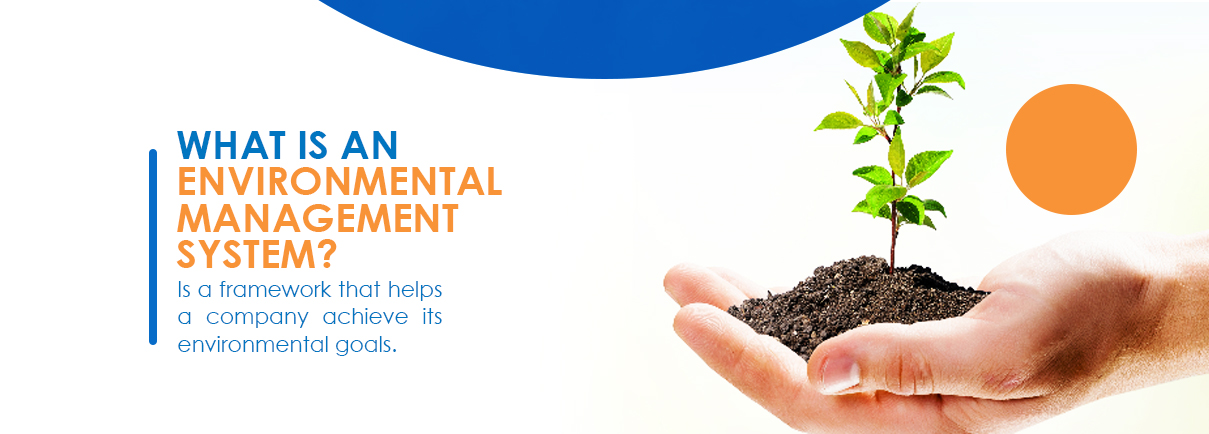
What Is an Environmental Management System?
An environmental management system is a framework that helps a company achieve its environmental goals. It helps an organization "identify, manage, monitor and control" their environmental issues in a holistic way, according to the International Organization for Standardization. Implementing an EMS involves consistent review, assessment and improvement of environmental performance.
The EMS of each organization is tailored to the needs of the entity using it. Each EMS is unique, but many consider issues such as:
- Air pollution
- Waste management
- Climate change mitigation and adaptation
- Resource use
- Soil contamination
- Wastewater discharge
- Degradation of ecosystems
- Loss of biodiversity
An EMS should also aim to achieve sustainable development, which requires a balance between the environment, society and the economy. Sustainable development meets the needs of the present without compromising the ability to meet needs in the future. An organization may also consider transparency and accountability related to environmental impacts as a part of its EMS.
Organizations certified to ISO 14001 must consider all environmental issues that are relevant to its operations. An EMS provides a systematic approach for accomplishing this.
Implementing an EMS can help an organization to:
- Prevent or mitigate adverse environmental impacts
- Prevent and mitigate potential negative effects on the organization from environmental conditions
- Fulfill regulatory, statutory and compliance requirements
- Improve its environmental performance
- Apply a life-cycle perspective to its products and service to prevent negative environmental impacts from shifting to other parts of the life-cycle
- Obtain financial and operational benefits from improved environmental performance
- Effectively communicate environmental information to stakeholders
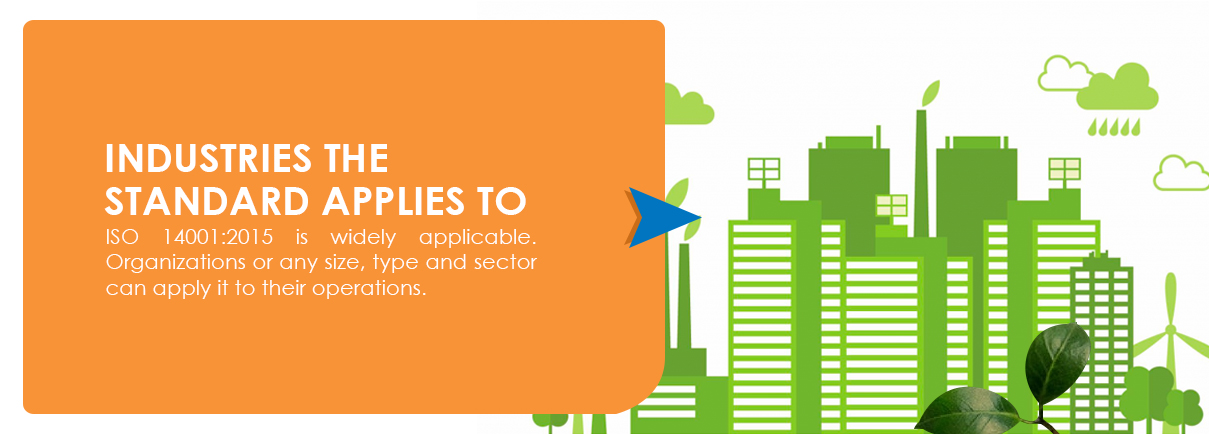
Industries the Standard Applies To
ISO 14001:2015 is widely applicable. Organizations or any size, type and sector can apply it to their operations. This includes private, non-profit and government organizations. There are currently more than 300,000 certifications to ISO 14001 in more than 180 countries.
Any organization that wants to improve its environmental performance, reduce its negative environmental impacts and demonstrate its commitment to sustainability can benefit from certification to ISO 14001. These entities can apply the standard to all environmental aspects of their operations that they can control or influence.
The fact that this standard does not include specific environmental performance criteria makes it much easier to apply across sectors. Organizations implementing an EMS may choose to apply it to their environmental policy, reducing their environmental impacts, preventing pollution, ensuring legal compliance, changing their corporate culture, using resources more efficiently, improving their environment-related communications and many other areas.
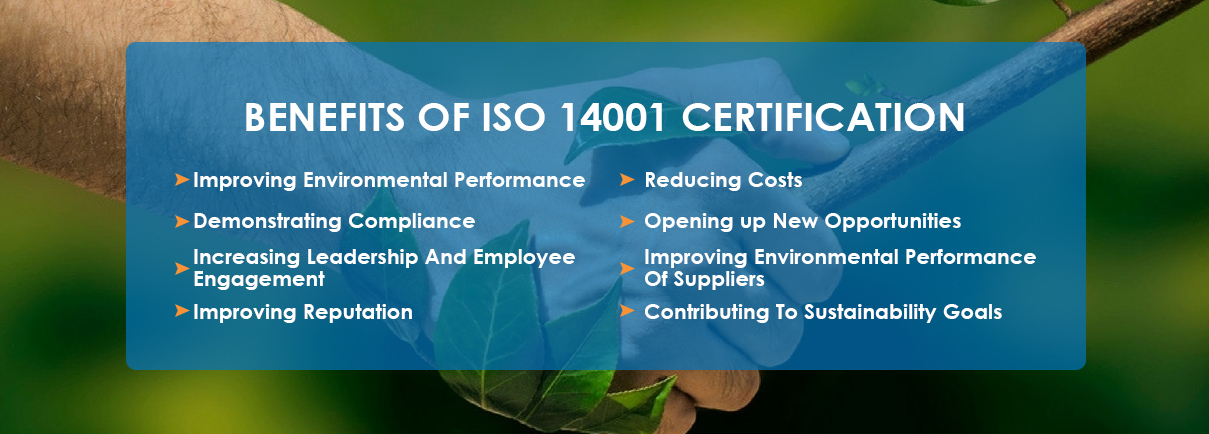
Benefits of ISO 14001 Certification
There are numerous benefits to implementing an EMS and achieving certification to ISO 14001. In addition to the benefits to the environment, there are also many business benefits that can be obtained. Almost any business can achieve these gains by implementing ISO 14001 either in whole or in part. Some of these benefits include:
1. Improving Environmental Performance
Implementing an EMS under the framework of ISO 14001 can improve an organization's performance in how it manages the environmental aspects of its operations. Depending on the needs and impacts of the organization, the standard may help a business reduce the pollution associated with the company's operations, improve the efficiency of its resource use, mitigate climate impacts or address other environmental issues.
2. Demonstrating Compliance
Certification to ISO 14001 helps demonstrate compliance with regulatory and statutory requirements. The standard can help you understand how requirements impact your organization and what you need to do to comply with them. It can also help you to be prepared for future changes in regulations.
3. Increasing Leadership and Employee Engagement
ISO 14001 focuses on participation from company leadership as well as employees, which increases the likelihood of EMS success. The standard requires buy-in from top-level company leaders, which ensure overall business objectives align with the EMS. Engagement from employees supports the practical application of environmental policy.
4. Improving Reputation
Environmental responsibility is increasingly becoming a priority for stakeholders, including customers, investors, employees and others. ISO 14001 enables you to demonstrate your commitment to the environment, which is something to which people will respond positively. Improving your environmental performance can encourage existing customers to stay with your company and attract interest from new customers and stakeholders.
5. Reducing Costs
Environmental initiatives, especially those that involve increasing the efficiency of your resource use, can help your company reduce costs and gain a financial and competitive advantage. Reducing your use of energy, water, materials and other resources decreases your expenses as well as your environmental impact.
6. Improving Environmental Performance of Suppliers
A full view of a company's environmental impact includes the effects of its suppliers. Implementing ISO 14001 encourages working with suppliers with better environmental performance and can help spot inefficiencies within the supply chain.
7. Opening up New Opportunities
Certification to ISO 14001 can open up new opportunities and help win new business. Some procurement specifications require certification. As an internationally recognized standard, it helps give potential stakeholders confidence in your company when expanding into new areas, even if they know little else about your business. Most organizations will also choose to work with an ISO 14001-certified company over one that is not certified.
8. Contributing to Sustainability Goals
ISO 14001 adds to many aspects of the United Nations' Sustainable Development Goals, which address the world's most pressing issues and aim to improve quality of life, promote peace and protect the environment. ISO 14001 contributes to goals one through 15.
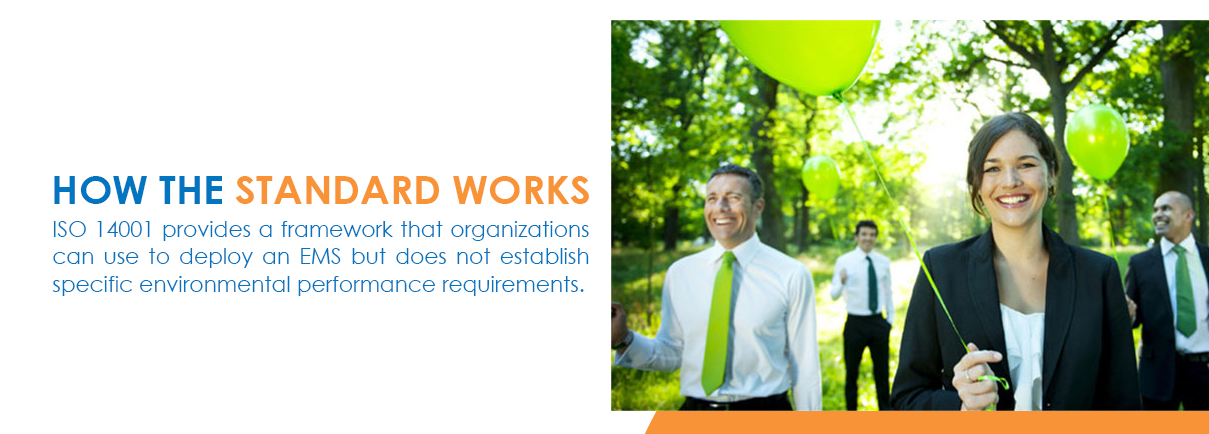
How the Standard Works
ISO 14001 provides a framework that organizations can use to deploy an EMS but does not establish specific environmental performance requirements. This is important for understanding how the standard works.
It is part of the ISO 14000 family of standards, which all deal with environmental management. ISO 14001 is the main standard in the family, while the others support it.
The standard is voluntary, and any organization can follow it and seek certification to it. Companies can use it in coordination with other management systems standards, such as ISO 9001. Doing so can improve the company's effectiveness in reaching its organizational goals.
ISO 14001 uses the plan-do-check-act (PDCA) model of continuous improvement. You can apply the PDCA approach to an EMS and each of its components. The process includes the following steps:
- Plan: Establish environmental objectives and the processes needed to bring about the desired outcomes.
- Do: Implement the processes as laid out in step one.
- Check: Monitor and measure the results against environmental policy and objectives and report the findings.
- Act: Take steps to improve the results and overall environmental performance.
This international standard also uses the Annex SL format, a structure that many of the new ISO standards use. This new format aims to increase consistency between standards to reduce confusion about terminology, increase interoperability between standards and minimize the need to repeat processes for different ISO certifications.
The Annex SL structure includes 10 elements:
- Scope: Provides the intended outcomes of the management system, which depend on part on the industry and the context of the organization.
- Normative References: Outlines the reference standards or publications that are relevant to the standard.
- Terms and Definitions: Highlights important terms and their definitions.
- The Context of the Organization: Aids with understanding the organization and its context, the needs of interested parties, the scope of the EMS and the EMS itself.
- Leadership: Describes the role of an organization's leadership and policy as well as other organization roles, responsibilities and authorities.
- Planning: Aids with the planning phase including addressing risks and opportunities as well as determining how to achieve objectives.
- Support: Addresses resources, competence, awareness, communication and documentation.
- Operation: Deals with the operational aspects of the EMS, including operational planning and control.
- Performance Evaluation: Helps with monitoring, measurement, analysis and evaluation of performance, including internal audits and management reviews.
- Improvement: Develops processes for improving performance, including addressing nonconformity, taking corrective action and striving for continual improvement.
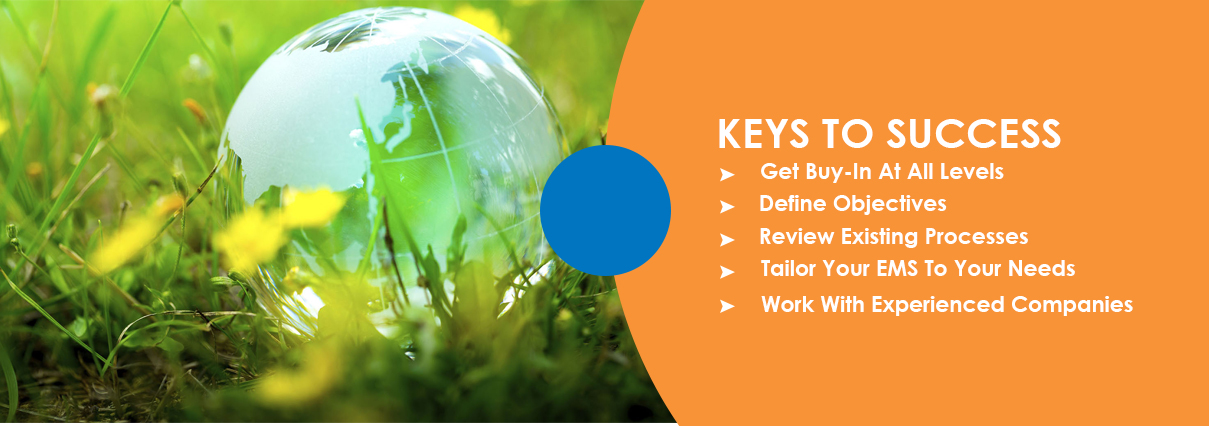
Keys to Success
Implementing and complying with the requirements of a standard such as ISO 14001 can be challenging, but taking certain steps can make success more likely. Here are some tips for success with ISO 14001:
1. Get Buy-In at All Levels
For the implementation of an EMS to be truly successful, a company must have buy-in and commitment at all levels. Employees will play an important role in doing the work of improving environmental performance, while top-level management must take a leadership role in deploying the EMS.
2. Define Objectives
It's important to define your goals before rolling out an EMS. Ensuring all necessary parties know what the organization is trying to accomplish through the EMS is crucial to success.
3. Review Existing Processes
Before you begin with a new EMS, you'll need to review any existing processes and systems that deal with environmental impact. You can then identify any gaps or areas for improvement. Gaining a thorough understanding of your current systems will give you an idea of where you're starting and enable you to create a more practical plan.
4. Tailor Your EMS to Your Needs
ISO 14001 does not prescribe specific environmental performance criteria because each organization is different and has different goals and needs. Apply this standard in a way that addresses your company's specific environmental impacts, policies, goals, compliance obligations, technologies and other factors. The level of complexity and detail of the EMS will vary among organizations. Implementing an EMS tailored to the needs of the organization will produce better results than taking a more generalized approach.
5. Work With Experienced Companies
Working with an experienced certification body can help the process go more smoothly. NQA conducts certification audits that meet all technical requirements, while also helping to improve your organization through practical, actionable information and feedback. Working with knowledgeable consultants and using resources, such as training courses, can be helpful as well.
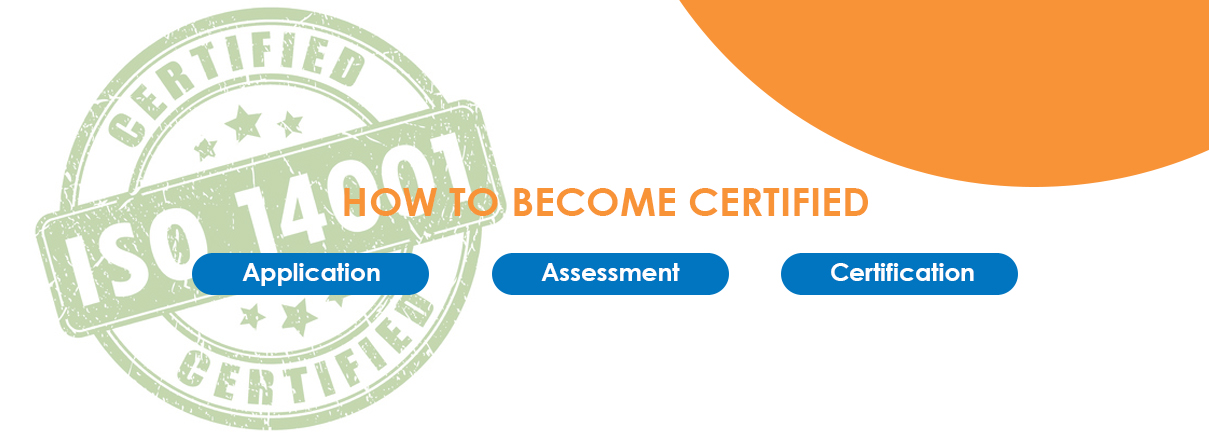
How to Become Certified
While using ISO 14001 without certification can be helpful, becoming certified to gives you access to the full range of benefits and enables you to demonstrate your compliance to third parties. Certification is recommended to get the most benefit from ISO 14001.
Once you have implemented your EMS, you can start looking into certification. Obtaining certification requires working with an accredited certification body, like NQA, that will perform the necessary audits and issue certification if your organization meets all the requirements.
The fundamental steps of the certification process are as follows:
1. Application
First, you will apply for certification by filling out a quote request form. This form will provide NQA with information about your organization, and it enables us to provide you with a quote.
2. Assessment
Then, you will undergo several audits to confirm compliance to ISO 14001. You must be able to show that your EMS has been completely operative for at least three months and that you have completed a full cycle of internal audits of the system.
The initial certification audit consists of two stages. The first stage aims to show that the organization is ready for a full evaluation. In the first stage, an assessor will visit the facility and:
- Check whether the EMS meets the requirements of the standard
- Check the implementation status of the system
- Confirm the scope of certification
- Confirm legislative compliance
- Create a report identifying any problems or opportunities for improvement and agree upon a corrective action plan with the organization if necessary
- Create an assessment plan and confirm a date for the stage two visit
- The stage two assessment aims to verify that the EMS conforms fully to the requirements of ISO 14001. During this visit, the assessor will:
- Take sample audits of relevant processes and activities.
- Document — using objective evidence — whether the system complies with the standard.
If the assessor finds any non-compliance or opportunities for improvement, they will report them to the organization. If the audit uncovers any major non-compliance, certification will not be issued until the assessor confirms that the company has corrected the outstanding issues. If the company does not make the necessary corrections within six months, they must undergo a further stage two assessment.
3. Certification
If, on the other hand, the assessor does not find any significant non-compliance issues, NQA will issue certification. The organization will maintain this certification through annual surveillance audits and a recertification audit after three years. The assessor will produce a surveillance plan and agree on a date for the first surveillance visit with the organization at the end of the stage two assessment visit.
The annual surveillance audits aim to ensure the company maintains compliance throughout the three years for which the certificate of compliance is valid. The duration and frequency of these visits depend on the size and structure of the organization, the complexity and risk associated with its activities and the number of management systems to which it's certified. During the surveillance audits, the organization must demonstrate that it is continually improving its EMS.
If the business changes during these three years, it can adapt its EMS to accommodate these changes. The surveillance audits will take this into account. Certification to ISO 14001 leaves room for businesses to grow, change locations, enter new markets and more while maintaining certification — providing all requirements are still followed.
After three years, your EMS must undergo a full audit to become recertified.
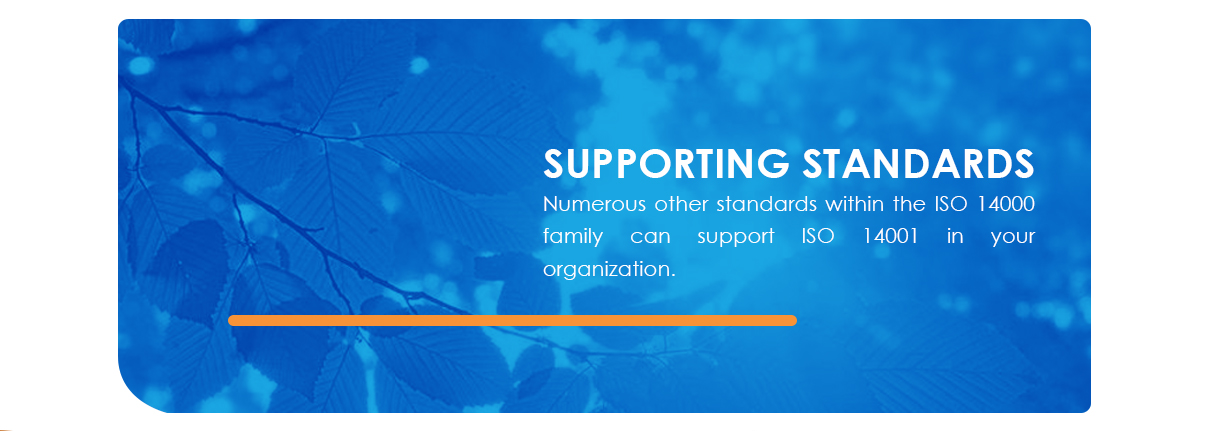
Supporting Standards
Numerous other standards within the ISO 14000 family can support ISO 14001 in your organization. These supporting standards go more into detail about certain aspects you may consider in your EMS. They include:
- ISO 14004: Provides additional general guidelines regarding principles, systems and support techniques.
- ISO 14006: Provides guidelines for incorporating ecodesign.
- ISO 14015: Provides guidelines for the environmental assessment of sites and organizations.
- ISO 14020: Provides information on environmental labels and declarations.
- ISO 14031: Provides guidelines for evaluating environmental performance.
- ISO 14040: Provides guidelines for conducting life-cycle assessment.
- ISO 14050: Provides information on vocabulary related to environmental management.
- ISO 14063: Provides guidelines and examples for environmental communication.
- ISO 14064 Parts 1, 2 and 3: Standards for greenhouse gas (GHG) accounting and verification to support emission reduction projects.
Another useful standard is ISO 19011, which offers guidelines for auditing management systems. Incorporating ISO 14001 with other management systems such as ISO 9001 can also enhance its effectiveness.
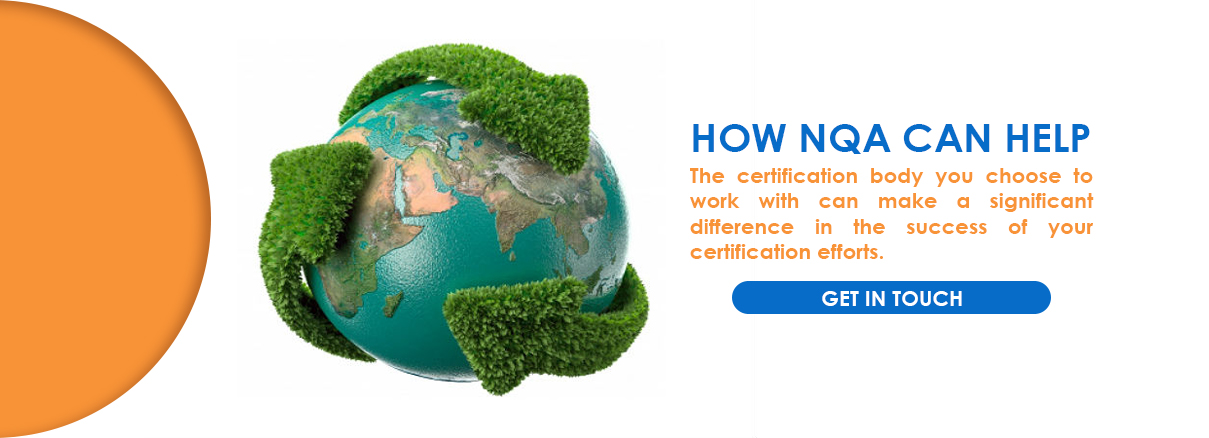
How NQA Can Help
The certification body you choose to work with can make a significant difference in the success of your certification efforts. At NQA, we provide our clients with excellent service and value. We offer audits that meet certification requirements and also help you improve your organization.
Here's how we can help:
- Gap Analysis: We can perform an analysis that will help you understand the amount of work and time you will likely need to deploy an ISO 14001-compliance EMS. This analysis can help you plan your EMS implementation.
- Consultancy Information: We do not provide consultancy, but we maintain a database of reputable consultants that can help you find one that fits your needs.
- Transition Guidance: We can provide resources and assessments that can help your organization transition from ISO 14001:2004 to ISO 14001:2015.
- Get a Quote: Apply for certification by filling out the full Environmental Management Systems Quote Request Form and sending it to our sales team. We will then provide you with a quote for the costs of obtaining and maintaining certification through NQA. We can then schedule an initial certification audit or other services.
For more information, feel free to browse the resources on our website. You can also request a quote, contact us directly, or give us a call.
